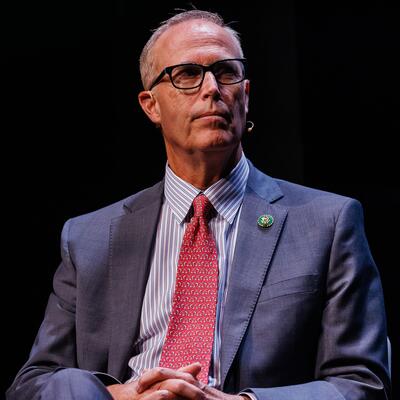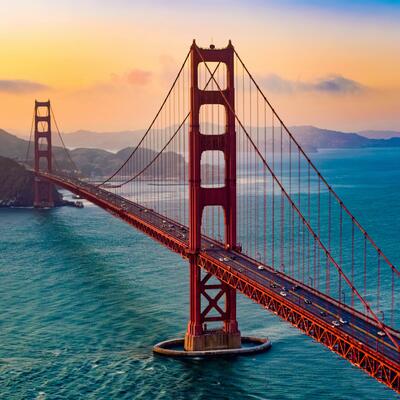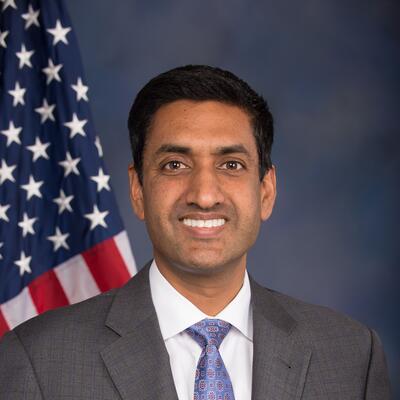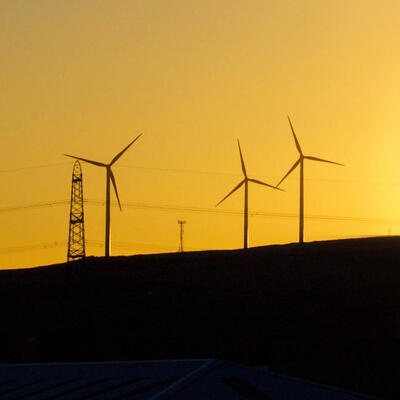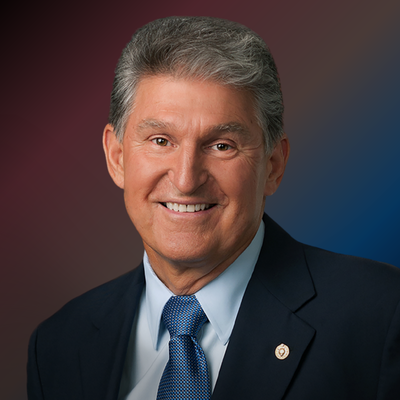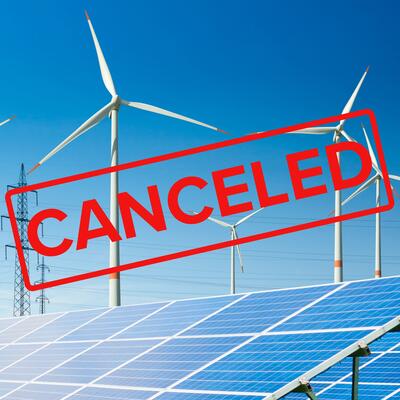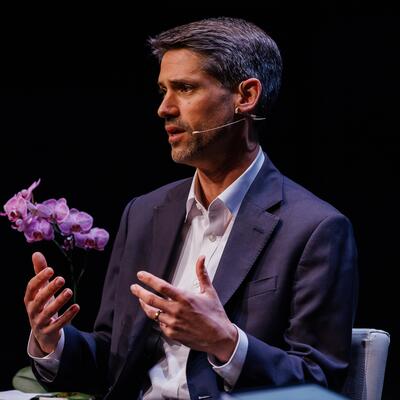
San José Mayor Matt Mahan: Live from SF Climate Week
Guests
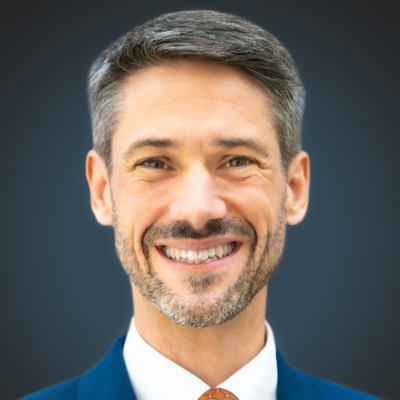
Matt Mahan
Summary
Climate progress is stalling at the federal level, making local action more critical than ever. “In an increasingly urbanized world, cities must play the leading role in achieving our climate goals,” says San José Mayor Matt Mahan.
But what does that look like in practice? What role can cities play in accelerating the transition to a fully electrified economy across all sectors? And how does he plan to secure funding in uncertain times?
Resources From This Episode (1)
Full Transcript
Note: Transcripts are generated using a combination of automated software and human transcribers and may contain errors. Please check the actual audio before quoting it.
Ariana Brocious: I’m Ariana Brocious. The whirlwind of San Francisco Climate Week is behind us, but we’re still processing the many powerful moments and conversations. With all the chaos and uncertainty emanating from Washington, it's really important to recognize the role of local civic policy and action on climate. As an entrepreneur, Matt Mahan helped create an app called Causes that Raise Money for nonprofit organizations, and he later ran another social medium for civic engagement. In 2022, he was elected Mayor of San Jose, California. For today’s bonus pod, we’ll hear his conversation with Greg Dalton on the Climate One stage during SF Climate Week in April.
Greg Dalton: So you've said that in an increasingly urbanized world, cities must play the leading role in achieving our climate goals. So how are you putting that into practice in San Jose?
Matt Mahan: Well, over the march of human history, we've seen this trend toward urbanization. More and more people over time live in, in denser urban environments. There's great economic mobility opportunities, but with that, cities have become the key leverage point for solving big societal problems, figuring out how to educate people, mobility solutions and energy is so foundational to the economy, of course. And so what we've done in San Jose is tried to take a little more control over our destiny. We became the nation's largest community. Choice energy aggregator in 2019. So we actually have taken over the power purchasing on behalf of all of our residents and businesses in the city. Nearly 1 million residents, , over 60,000 businesses over one gigawatt of demand that we are purchasing. Every, uh, year, and usually we're doing 10 20 year power purchasing agreements on behalf of our residents, which gives us the ability to help make a market for renewable power. We're purchasing hundreds of millions of dollars worth of power where we work with generators to plan out our needs and help them build new capacity.
Solar, wind, often paired with storage solutions. So we're helping to make a market by using our purchasing power.
Greg Dalton: So there's been a lot of concern lately about rising, electricity costs in California and elsewhere.
for lots of reasons. I think rates have gone up 50% in the last several years. Does that mean that , the people in that municipal power, are they insulated from those price increases? You know, somewhat or all?
Matt Mahan: Somewhat. Our rates are about 8% lower than the standard pg and e rate, so there is a discount there. PGE still owns and, and manages the. Infrastructure for , long distance, uh, transmission and the local distribution.
And we're responsible. Our rate payers are responsible for paying for those costs in the state But, uh, we, we are able to offer. A discount and I, I think the important lesson here for us, not just as a city, but as a state and a country, is that we have to keep investing in innovation.
California is at a point where we have deployed so much solar generation capacity that as you probably already know, in the middle of the day, we have just an incredible excess of power on most days. I see that in my own home. I have solar panels and a couple of batteries at home. In the middle of the day, we're generating a ton of power.
Problem is nobody's home. So luckily with those batteries, we're able to capture that and use it at night. We need to invest massively. The innovation is not done yet. We need long duration storage to handle that seasonal shift from the summer when we produce an excess of power, uh, to the winter and, and from daytime to evenings.
And so we need to keep innovating and we can't solve this by prematurely just. Pushing out other sources of energy, whether that's nuclear or even even gas. We're still reliant for a while. And in the meantime, we need to accelerate the technological innovation and adoption of these new tools that are truly carbon neutral.
Greg Dalton: And one innovation, uh, that's going on, , downtown San Jose. There's a proposed new net zero community that promises to bring together two, two real problems, data centers and housing.
I never thought about those, you know, connected in any way. This is a proposal to bring 4,000 units of housing and three new data centers drawing 200 megawatts of electricity. That's a lot of electricity. So, you know, is this too good to be true?
Matt Mahan: Well, we'll find out. We just cleared some of the barriers in terms of zoning and the permit application process to enable a data center to at least theoretically come downtown. In fact, we have a couple of small ones already, but it's obvious that there's huge demand for computing power and you see data centers being built.
All over the world at incredible scale, and they consume a tremendous amount of energy. And our thought has been given that we have the capacity to serve more load in and around our downtown core. And given that there's tremendous demand and these data centers are financable today, unlike most things in California housing, for example, unfortunately, perhaps we can enable.
Vertical data centers on the edge of downtown connect the approval of those data centers to the developer being willing to help finance housing nearby into a holistic project where the, they're connected, the buildings are connected underground, and all of the energy use in the data center that's kicking off a lot of [00:05:00] heat.
That's generally wasted if you build these big, sprawling data centers out in the middle of nowhere, can be captured and then pumped into the neighboring buildings to meet the heating or cooling needs of nearby residential or other uses. Now, this is still largely theoretical, although there are district energy systems that exist at real scale out in the world.
Uh, but the idea here would be to actually have the data center generating. All of that excess heat because they're running 24 7 and, and, and spitting off a lot of heat. So that's the theory. It's one of the few places where capital in California can be deployed to build something and rather than have it generate a lot of wasted heat, we can use each electron twice and get something we desperately need, which is housing.
But do it in a way that helps our entire downtown ultimately become carbon neutral. So that's the theory. We have a, very reputable builder that's built tens of thousands of homes up in Canada, west Bank and Seattle and other markets partnering with pg and e, and they conceptually feel that this is quite viable.
We've tried to do our part by clearing the hurdles from a regulatory perspective to allow a demonstration project to move forward on the edge of our downtown.
Greg Dalton: It's exciting to see things at this kind of scale. 'cause we know, like I have induction, cooktops don't have gas in my home. , but really the savings come in when that happens neighborhood wide and district-wide to work at that scale rather than, and so it seems like a real win-win. So you're not.
using energy to cool the data centers, and you're not using energy to warm the homes. You're taking heat from one place to the other. I hope that works
Matt Mahan: the idea. And if we get the grid to be completely carbon neutral, that first electron into the data center can be carbon neutral.
And then we can use it twice
Greg Dalton: There we go. And so, but you know, other parts of housing. Housing is a big climate lever. There's a real crisis of affordability. There's not enough homes in this state. We need to build more. Everyone's agrees on that. They just think it should happen somewhere else across the street and another line.
So how do you approach housing as a climate lever? Because it just, it's so, it's this puzzle that, [00:07:00] you know,
Matt Mahan: yeah.
Greg Dalton: policy has not solved yet.
Matt Mahan: I appreciate the efforts of your state senator here in San Francisco, Scott Weiner, assembly member Buffy Wicks just across the Bay, and others who are trying to rightsize our permitting processes and our environmental review processes to better yield the outcomes we want.
The California Environmental Quality Actor, CQA. Is there for a reason. We want to review investments and make sure that they are environmentally sensitive and that we're not putting a factory right next to a school or that sort of thing. But ironically, the levels of process and regulation and local fees and the costs that we've imposed on the very kind of housing we should most want.
Dense housing and mixed use urban environments near transit, which is the most climate friendly, the process around it and the fees are such that many of these [00:08:00] projects, even when approved by a governing body and in San Jose, we've approved thousands of units in that format. They simply aren't getting built because they aren't financeable the cost to build after all of that wait time, all of those regulations, all of those fees is so high that a developer literally can't get a loan from a bank to go build that housing.
And the terrible irony of this, and it's not all because of CQA, but it's a contributing factor, is that the path of least resistance is then to go by. Open Greenfield farmland in the Central Valley or some other remote area, pave it over, build low density housing and condemn people to commuting 2, 3, 4 hours a day to get to a job.
It's the least climate friendly thing we could possibly do. So my argument would be, and this is an oversimplification. if I had a magic wand, I would encourage Sacramento and all of our localities to waive all of the fees, dramatically reduce process and make it essentially turnkey to build up in [00:09:00] places like downtown San Jose and the urbanized transit supported mixed use, walkable.
Urban parts of our state to get real density in those areas and, and then make it harder to build out where it's least climate friendly. But right now, by default, even though it's not our intention, we're doing exactly the opposite.
Greg Dalton: Right. This is the, you know, San Francisco that had what the million dollar, toilet in a park, you
Matt Mahan: it was 1.7
Greg Dalton: Right? And so all these fees get laid on this, you know, ESER Klein's a really thoughtful person in New York Times, says that, you know, liberals have kind of captured, achieved regulatory capture here.
That, and so, you know, is this a place where liberals and coastal people's like, yeah, we like it the way it is. We don't want any more building in our, in our neighborhoods. We wanna keep it the way it is.
Matt Mahan: That, that seems to be the dynamic. I've been reading Abundance by Ezra Klein and Derek Thompson actually saw them speak, uh, here recently, and I think, I think they're really on to something. I think that the, the insight is that we should not.
It we, we ignore the reality of markets at our peril. And what I mean by that is while markets need to be regulated and shaped and we have to protect people in the environment from the excesses of capitalism, if we go too far and simply say no and throw up a lot of roadblocks and friction and make it extremely hard and expensive to have any investment in growth, there will still be demand for things.
It will just. Be realized somewhere else where there's less regulation. And then because we're in a global economy, in a, in a global environment, the reality is that if they're building out in Texas, because it's easier in the long run, it affects all of us from a climate perspective. If we stop production in the United States, but it's all being produced in factories where there's no environmental regulation halfway around the world, eventually that's gonna catch up with us.
And so we need to strike the right balance of. Getting the things we want in terms of regulation and protections, but not so stifling the market, that it simply moves somewhere where there's no [00:11:00] regulation because it's still gonna happen. People are still going to want to buy things. They, we, we still are going to have energy demand.
So the notion of abundances, let's get more of the things that people want. It's hard to change human behavior, but let's try to make it as clean and innovative and efficient as possible.
Greg Dalton: Yeah, they're really onto something. Earlier this year, members of Congress announced $12 million in federal funding for 230 ev charging ports in the city of San Jose.
Now, there's all sorts of lawsuits and situations about that money that was appropriated by Congress being clawed back. Where does that stand now? Do you have that $12 million?
Matt Mahan: do not. So we have not received the funds yet. And there's great uncertainty. We are worried about federal funding across a number of categories.
Cities like San Jose are a little bit less exposed than counties. Counties can have 30, 40. 50% of their revenues come from federal sources that theoretically this administration might try to freeze. Cities like San Jose, it's more like 10%, but [00:12:00] these are critical funding streams for climate programs, affordable housing, transportation upgrades, public safety investments, and the threat from the administration is to tie.
The disbursement of those funds to, other policy changes that have nothing to do with housing or climate, uh, such as their preferred stance on immigration. And essentially say until a city or a county complies with the preferences of this administration on all of these other policies, we won't.
Follow through on the grant funding. Now, we had some good news today. We actually, a, a federal judge here in San Francisco just actually issued an injunction against the federal government's position. We joined a suit along with San Francisco and our county down in Santa Clara in the South Bay, and we won this round,
Greg Dalton: which
Matt Mahan: which doesn't.
Surprise me, but it will certainly be challenged and we're going to continue this litigation to try to get to a place where we hold this administration [00:13:00] accountable for allowing federal grant money to flow to localities for its intended purposes, to achieve the goals that the monies were allocated by Congress to achieve.
Greg Dalton: Right. It's one thing to get an injunction to say you can't take this money, but it's another thing to really force them to cough up.
Matt Mahan: get the
Greg Dalton: Right. Yeah. It doesn't mean there's, there's a standoff there. So, so how do you govern in all this uncertainty with, you're not sure, you know, the way the money flow, that's, what does that do to city
Matt Mahan: Well, it does, it slows us down and it means that we, it's harder for us to be as ambitious and bold as we would like to be in certain policy areas, but to, to the extent possible. We are trying to take control of our own destiny. I talked about our community choice, , energy program that we have.
We are using the net revenue. I mentioned that our. Costs are lower than pg and e. We don't have to return profits to shareholders. We don't have to pay very expensive executive [00:14:00] compensation. we are able to reinvest those dollars in the community. So while we won't have as many EV chargers as we would have with those federal dollars, and we hope to still get them, we're deploying local dollars in expanding our charging network.
We are helping small businesses and residents upgrade their appliances to electrify everything in their homes and do that in a way that they, uh, they can afford. Later this year, we'll be rolling out incentives for residents and businesses to buy battery storage, which at least for most of the year.
Can handle that shift from all that energy being produced in the middle of the day to when a lot of it's consumed in the evening. I still think there's a role for r and d and our universities and entrepreneurs to really look at that long duration storage issue. How do we do handle that? Seasonal shift is still largely, uh, not answered in the real world at grid scale for California.
That's really the next frontier. That's a [00:15:00] little beyond the resources of the city, but we'd love to be a Guinea pig if anybody wants to test those solutions in San Jose.
Greg Dalton: Yeah, storage of of different durations and different scales is really exciting and important right now. you installed irrigation systems in Bolivia after college? Uh, I worked, I think for Teach for America. How did those experiences shape your thinking? I.
Matt Mahan: Well, it's a broad question. I, I think the through line I've had a, a strange career in the sense to, to your point, I started out doing economic development work in Bolivia. It was irrigation systems and windmills actually. And then was a public school teacher, went into the tech sector for years, built a couple of civic tech companies, and then got into the public sector.
For me, the through line has always been. Trying to organize people. I guess I'm sort of just inherently a community organizer, trying to get people connected and organized around doing hard things together. Things that we could never do alone, but if we come together and leverage everybody's resources, get everybody rowing in the same direction.
We can overcome big challenges and achieve big things for our community. And I've always loved that problem of how do you get people organized and in dialogue and actually setting goals and working together on really big challenging problems. There's probably no problem bigger and and more challenging than our climate crisis in San Jose.
We're working very hard on our housing shortage, our homelessness crisis, and a number of other issues that I find fascinating. But ultimately. They're collective action problems. They require us to engage and educate a lot of people and mobilize action from diverse sectors. There's no, uh, one, you know, king or queen who can just by fiat say, we're gonna go do this.
We have to actually mobilize an entire community.
Greg Dalton: And one of the terrible things about climate is the people who contribute, uh, least are often affected most, and there's vulnerable communities, uh, particularly around extreme heat and air quality issues.
I know, you know, the, it's getting hotter in, in San [00:17:00] Jose. , so what are you doing to address and protect vulnerable communities, to climate impacts?
Matt Mahan: Yeah. And flood risk. Of course. We should also talk about, and and you're right, it is often our, um. Lowest income, most marginalized communities that are in the places that already have the least urban, canopy cover, for example, or the most likely to be in a flood zone.
we are trying to be very intentional about multi-year strategies for addressing these challenges. We've significantly ramped up. Tree planting efforts, both a combination of, local dollars and grants from Cal Fire and other partners, as well as fees on developers. When a new development happens in the city of San Jose, we are, I forget the exact ratio, but it's enough funding to plant five trees for everyone that's, that's removed, for example.
And, so last year in the city, and we mobilized hundreds of volunteers to help with this, we planted over 3000. Trees And so we are moving very aggressively to hit that benchmark of having 20% of the city. From an aerial view, have canopy cover because we know there are myriad benefits from having a healthy urban forest, but it also has to, to your point, to be distributed fairly around the community.
And so we have a, data. Equity team at the city that looks at those impacts of our programs and thinks about how do we ensure that the investments we make are especially impacting communities that have been traditionally underserved, whether it's investing in our parks or planting.
in the community.
So that's, that's been a big push of ours. We're also, we had terrible floods. People may not remember this been 2017. We had hundreds of people displaced, many homes damaged, tremendous amount of damage from flooding. We're, we're in a valley and have three major waterways that converged near downtown and then go, go out to the bay, two of which converged, but um, head out to the bay.
And so we've been working to restore the habitat [00:19:00] to help our unhoused community move indoors into basic dignified shelter and start to repair the, um, the riparian corridors and clear them out of a lot of debris. Replant native. Plants, and that goes all the way out to the bay. Where, believe it or not, we have real exposure to rising sea levels even down in Silicon Valley where the bay, uh, is, is right along, a part of the city where we have alviso, one of our lower income neighborhoods of 5,000 residents.
Our wastewater treatment facility, critical infrastructure tech companies, are all within, uh, a very short distance of the
Greg Dalton: and you mentioned collective action, sea level rise and the, the South Bay is sinking and lower, more vulnerable. but that's a collective, uh, action problem because no one city, no one county even, can address that or have the resources. So how, how do you address something like sea level rides, which is, seems like it's slow.
What's an inch here or there? What's the big deal?
Matt Mahan: Well, the state has a, uh, there, there's a [00:20:00] bill, and I'm forgetting the number now, but essentially one that requires collaboration. We're thankful for this around the shoreline, and so our county, city Water District, army Corps of Engineers.
Have to plan together and invest for rising sea levels. So we are planning for major work that would restore over 2000 acres of wetlands along the, the southern portion of the bay where our city limits are in that alviso area. It's a beautiful area, by the way, if you ever get a chance to get down there, there's a wildlife refuge there, burrowing, owl, and other interesting species.
We're restoring wetlands, we're increasing levies and figuring out how to better protect critical infrastructure. You, you liked the win-win of vertical data centers paired with housing to capture all that excess heat and use it twice. We're exploring the possibility of using the, the dirt. We call it the muck that [00:21:00] would come out of the future.
BART Tunnel bringing Bart to downtown San Jose using all of that removed. Earth and taking it just right up the road to the bay to help reinforce those levees. So rather than shipping it off, we could actually just run it right up the rail line and use much of it right there to help reinforce and expand levees.
But the, the, a big piece of that is just restoring the wetlands, which provide that natural buffer.
Greg Dalton: Yeah. nature's bumpers. So if resources were not a constraint, uh, what Bold climate initiative would you like to see? I.
Matt Mahan: Oh man. Well, I'm pretty, , I am very focused right now as you've heard me mention a couple of times on this issue of storage.
we were the first big city to pledge to be carbon neutral. By 2030. But we have to, and, and we're on track to do that, that that's when it comes to our purchase of power. We're at 62% today. By 2030. We have a plan to have 100% of the power we [00:22:00] purchase on behalf of our residents and businesses in the city to be 100% carbon neutral.
But we have to acknowledge that includes various kinds of credits. And the reality is when you just look at the electrons on the grid. Second by second, and then total that up year round. There's still a lot of need right now for gas peaker plants to fill in that gap. And some of that may be at the margins is okay, but it's gonna be very hard to be truly a.
100% GHG free if we don't solve storage. So I would start by saying, given that we are one of the cities in the country with the most deployed rooftop solar, I would love to go out and incentivize every homeowner, every resident in the city to get either batteries or an EV with vehicle to grid. hookups where the, the vehicle could be charged in the middle of the day when there's all that excess solar power being generated and then power the home at night.
And so that's really, that's where I would go. I would look at how we scale up in a distributed way, charging and storage in both vehicles and, and home batteries.
Greg Dalton: Yeah. I went and I, I have an ev and then I bought a, you know, a big battery. I was like, oh, that's kind of dumb. The EV is a big battery. It's problem. Yeah. Yeah. but the technology wasn't quite there for vehicle to grid vehicle to home that that is coming now.
It's coming. , both at the panel level, et cetera. So, San Jose, the San Jose region is set to hold major sporting events soon, next year, super Bowl 60 will be, and also several World Cup events will be held, uh, nearby at Levi's Stadium in Santa Clara. These kinds of high profile events tend to put a spotlight on civic leaders.
What's going on? This is happening in Los Angeles ahead of the 28 Olympics. What's, what's the city doing on transportation? Carbon footprint. One of the selling points of La Olympics was they don't have to build a lot of new, new stadiums. So what is your region doing leading up to this next Super Bowl in the World Cup to [00:24:00] to be cleaner?
I.
Matt Mahan: We're very excited. We'll be the first metro area to ever host Super Bowl and World Cup matches. In the same year, we'll see something on the order of half a million people from outside of the region, plus millions of people locally participate in some way in these global sporting events.
We are planning to have. Incredible fan experiences in downtown San Jose, and one of the benefits of that is it's very walkable. You can fly into not the most climate friendly mode of transportation. I understand, but if you're coming from out of the country, you're most likely flying
Greg Dalton: right. It we're all carbon centers.
It's okay. We don't need
Matt Mahan: I've, yes. Right. Those of us in glass houses. Right. Um, you can fly into SJC and be. Five minutes from downtown, stay in, in a hotel and have most of your experience will not be at the stadium that's maybe 5% of your time in town. A downtown, a mixed use urban environment is highly walkable. We have hundreds of restaurants within a short walk of hotels downtown.
We plan to [00:25:00] have watch parties and. Drone shows electric drones, and things to do in the downtown course so somebody can spend 90% of their time in a walkable environment when it comes to getting to the game. Or if somebody wants to come up and visit San Francisco, for example. We now have electrified Caltrain.
We are working with our transit agency to make sure that we can run extra bus and light rail service. Luckily, Levi's Stadium where Super Bowl and World Cup matches will be played is a very short 10 15. Minute trip from downtown San Jose and you can do it on transit. And so we wanna highlight the existing infrastructure.
I also think there's an opportunity to invite the Waymo's of the world. We're lucky to have Archer Aviation and Joby two of the leading electric takeoff and landing. Aircraft, uh, aviation companies in the world, headquartered in the South Bay, one in San Jose, one in Santa Cruz. Would love to show off all of this [00:26:00] innovation.
Back to this point about abundance. People are gonna want to get around. We're not gonna convince people not to fly. What we need to do is make it clean. And I think our goal here should be to show off as the world's leading center of innovation that we can live abundant lives with lots of options, lots of great experiences, very full lives without having to destroy our environment and the path to getting there is innovation and there's no better place in the world to invent and, and reimagine the future than San Jose.
Greg Dalton: Okay, sounds good. But would you get in a battery powered electric air taxi today?
Matt Mahan: you're hearing this first, I would happily fly one from downtown San Jose to Levi Stadium if they'll let me do it.
Greg Dalton: Okay.
Matt Mahan: Well, that's, that's up to the FAA,
Greg Dalton: like to invite Sally and Carol to come to the audience, uh, to the microphone. Over here, Sally and Carol, to present your questions. Welcome for, for Mayor.
Audience: Yeah. I know my question. Okay. Uh, thank you for the opportunity. Um, I don't want this to sound naive because I've been out of the, working with solar and congregations now for about five years, but we used to have the ability in San Francisco to put solar on your roof, and if you created more than you used in your house, it could go back to the grid for credit.
Do you have that in San Jose?
Matt Mahan: Well, it's a thank you for the question and it's governed by a statewide policy, and I'm sure Greg knows a lot more about it than I do, but recently the state, really it was the CPUC, as I understand it changed the rate at which you get paid. It's significantly lower. I was just looking at my bill the other day, and I think you get about a cent per kilowatt hour versus what used to be a significant multiple of that, and the market rate is, is.
Can be 40 cents per kilowatt hour, so you're getting a very tiny payback [00:28:00] now with the latest tier of, of net metering. Is is the, the program, I think part of what they're finding though and, and what, where the state needs to move faster, in my opinion. Is toward rewarding storage as a, uh, a, a demand is something that you can demand energy from.
So if somebody installs a battery or with vehicle to grid charging connects a vehicle, you should be paid a really meaningful competitive because close to a market rate, if not at market rate, to supply that service. I think the state is recognizing that. We what? We, we don't need it so much more. I'm never gonna say, uh, that we shouldn't have more solar generation.
We should be a net expert border of power in California. But our greatest need right now is not more solar panels on roofs in the middle of the day. Not that it's bad to do, but I, I, I mean, I can show you my chart. I, I Now look at my little home solar chart on my f. Phone more frequently than I look at social media because I'm so [00:29:00] fascinated to see how my solar panels are doing.
And in the middle of the day, it's just cranking away, generating all this power. And I send most of the power to the grid every day because there's no electric vehicle at home to capture it. We have two Tesla Powerwall batteries that are full by 11:00 AM and then we're just sending the power out. And so what we need is better ways to capture the power and deploy it when it needs to be used.
And whoever's doing that. Providing a service that they should be paid for.
Greg Dalton: Right. And some, uh, some areas are moving toward that.
Try to vert the whole virtual power pan on a, on a system wide to use the batteries and the cars that way. Uh, Carol, welcome.
Audience: Hello. Thank you. Um, great to hear about all this innovation. Um, I am really interested in how we can use California's immense economic power.
We just became number four. Japan just dropped to five, um, to hold the Trump administration accountable to the laws. Um, [00:30:00] and you know, my idea had been why can't we withhold California taxes and put it in an escrow fund and then release it when the administration follows our laws
Matt Mahan: or
Audience: When they give us damages for the water that they released, that was like ridiculous instead of giving it to la.
So, you know, I hear a lot about California economic power and soft power leverage points. I'd like to hear how we can use it and, and just one add-on insurance is another thing. California's economic power, all of our residents are getting our home insurance dropped. I know this is state.
Greg Dalton: There's a couple there. Thank you. So insurance and are you gonna make news here? You're gonna withhold, uh, taxes.
Matt Mahan: it's, it's above my pay grade, unfortunately. I think the reason states can't do that is that the federal government has a, has a big army. So we, we probably can't do that. What we do do though, is we try to use the justice system and San Jose, San Francisco, other partners across the state, the state itself are investing in, in making good rational legal.
Arguments, and I understand there's real fear that, that those may not be respected. I have to believe that as a, as a bedrock of our democracy, that the majority of Americans will at the end of the day, respect rule of law and listen to rational argument. It's gonna be messy. We've had times in our, we.
Past as a country where, uh, we haven't always lived up to our ideals, but I am hopeful that through legal action, through argumentation and persuasion, we will in the long run see common sense and justice prevail. And we are investing our lawyers, very talented lawyers' time in the city of San Jose and joining other jurisdictions in the state in making those arguments and building the case and trying to persuade both the community and the justice system of what's right.
I will say what is more within my controls, mayor of a city in California and other electeds locally is making California. We have this economic might. We have the tax base, we have the innovation, we have the talent, we have tourism. We have so many assets. We need to make our cities and our state a shining beacon of success that others want to emulate.
We need to address again, our own house in order. And it's not to say that we shouldn't fight the Trump administration when they try to do unlawful things, we absolutely should. But to the extent that our cities can be a shining example of clean, safe, economically inclusive, vibrant, and innovative places where people wanna spend time, want to move, people vote with their feet.
In the long run, making our cities and our state extremely successful and making Californians proud to live here and making others want to copy us. Being cultural leaders, I think in the long run is how we ultimately achieve that better future that we all want.
Greg Dalton: Well, mayor Mahan, thank you very much for coming up to San Francisco for Climate Week and sharing your leadership and insights with us.
We really appreciate
Matt Mahan: Thank you for having me. I appreciate it.
Greg Dalton: Yeah, great. Thank you.
